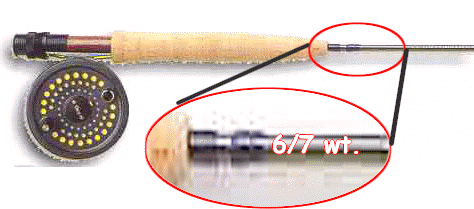Rod Weight
The classification, "rod weight", is a somewhat confusing standard because the actual physical weight of a fly rod has nothing whatsoever to do with its "weight." When fly fishers discuss "what weight fly rod are you using?" . . . or, "rod weight" in general, they are not talking about how much the fly rod weighs. Rather, they are referring to the rod's "weight class" as determined by a standard classification system that is used to identify fly rods. Fly rods are made to balance with a specific fly line. Essentially, the fly rod "adopts" the rating of the fly line with which it is balanced. Fly lines are classified by a "weight" system based upon how much the first 30 feet of the "working portion" of the line weighs in "grains". (A grain is a unit of measure. The "working portion" measurement omits any tip on a taper in the fly line. It is not important to know what these details mean, but what the relative size is compared to other fly lines. Our separate chapter on Fly Lines covers this matter more thoroughly. For a complete description, please refer to Fly Lines.) Weight classifications: from 000 to 15
Fly rods and hence fly lines traditionally come in "weights" from 1 weight to 15 weight; "1 weight" being the smallest/lightest weight, "15 weight" the biggest/heaviest. Rods just coming out are being labeled as "0", "00" and "000". In this course, and elsewhere, you will frequently see the weight classification abbreviated as "wt." for both fly rods and fly lines. When a fly rod is said to be, or is rated as, a "6 weight rod", this means that it is made to be used with a "6 weight fly line." A "9 wt." rod takes a "9 wt." line; a 3 wt. rod, a 3 wt. line; and so forth. One rod, 3 line weights Modern graphite fly rods, regardless of length or rod weight, can handle multiple lines. Most are capable of efficiently handling one line weight above and one below the line weight for which the rod is rated. For example, a 5 wt. rod can also be used with 4 or 6 wt. lines. Which way is up? The relationship between this rod/line weight classification and the size/power of the rod is a direct relationship . . . in other words, Bigger = Bigger, &, Smaller = Smaller. For example, a 10 weight rod is "bigger" than a 9 weight rod, as are the corresponding fly lines which are labeled the same way. Likewise, a 3 wt. rod is "smaller" than a 4 wt. To further define "bigger" and "smaller" in fly rod terms, keep in mind we are not talking about the relative sizes of the two dimensions of the rod, its length and physical weight. We are talking about the rod's capacity to cast a heavier line. Let's look at a couple of examples to clarify what we mean:
So with all this confusion cleared up, exactly what "size" rod should a fly fisher select? See "selecting a fly rod" for a process to help you decide. |
Some Fly fishing
When
When referring to
fly rod weight
classifications:
When
referring to fly line weight classifications:
When
When
referring to fly size:
Most fly rod manufacturers put the line weight for which their rods are rated on the rod blank, just in front of the grip, or on the butt cap. They may also put a model number here, often keyed to the rod's length & line rating. e.g., a model code of "8367" would mean an 8' 3" rod for a 6 or 7 weight line. |
|
|
|
